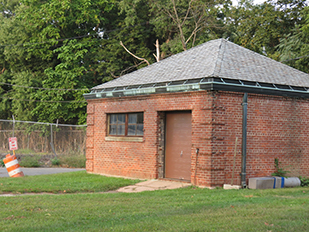

In 1949, this pump house was constructed to end the dumping of raw sewage into local rivers from the former state prison.
Tour Offers a Glimpse at Wethersfield’s Former Prison
By MARK DIPAOLA
WETHERSFIELD - To many, a trip to the local motor vehicle department might feel like a long prison sentence, but few probably know that in Wethersfield, where the DMV currently stands, was once, in fact, just that. From 1827 to 1963, the area that stretches from the Solomon Welles House and the parking lot behind the DMV building was Connecticut’s state prison.
Last Tuesday, a crowd of about 100 people have gathered at Solomon Welles for what was advertised as a tour of a prison. Looking around at the rustic building--the site of the weekly Farmer’s Market--and the suburban homes and soccer field surrounding it, it’s hard to imagine, but relics from the area’s less glamorous past remain.
Wethersfield Historical Society’s Mary Knowlton led a smaller party (the crowd was broken into four tour groups) to a flag pole that has stood since 1901 in the back of the Solomon Welles House heading toward State Street. This was the entrance to what she was about to describe in a series of dated sketches of the old structure.
â€Е"The sleeping cells were in the front,” Knowlton said, pointing to the drawing of a building that once held every kind of prisoner from insubordinate union soldiers to Wethersfield locals in its confines. Unlike today’s institutions, which tend to be gender homogenous, the old state prison had female inmates, as well. In the facility’s early years, 14 women were kept in one communal room, according to Knowlton.
As the prison expanded, women were eventually given cells, as the facility’s grounds began to stretch further down State Street, the direction Knowlton led the tour following her brief introduction. Outside the entrance to the DMV building, Knowlton pulled out another sketch--the building from the previous blueprint was there along with much more.
â€Е"The old part of the prison would have been this section,” she said. â€Е"So you can see how it expanded. This is for the improvement of the health of the prisoners.”
Maybe, but the prison’s conditions were far from comfortable, even compared to modern facilities. inmates were typically given two showers per month â€Е"if they were lucky,” according to Frank Morsky, another tour guide.
But by 1899, the state was at least trying. The focus during this period was improved ventilation for inmates. Part of that plan included more cells--472 were added in 1897, with 200 more put in by March of 1901. A $36,000 psych ward was also constructed during the expansion.
Behind the DMV sits a small pump house, which was constructed in 1949 and ended the practice of the prison dumping raw sewage into local rivers and streams. Close by is a concrete garage, which was built in seven weeks exclusively by inmate labor in 1938.
â€Е"It served the purpose of teaching inmates [auto] mechanics and teaching a trade,” Morsky said.
Next, the tour marched across the soccer field and green, with residents tossing Frisbees to the tour’s last stop--a single grave plate punched into the ground and reading â€Е"State of Connecticut Prison Cemetery: 1827-1963”..
â€Е"Thirty-six bodies are buried here right now,” Morsky said. â€Е"Nine were executed--all by hanging.”
Bet the DMV isn’t looking so bad now.








